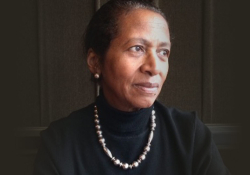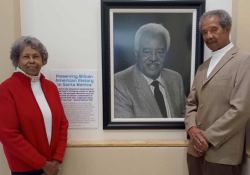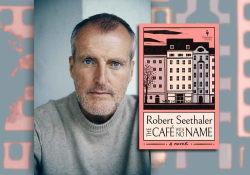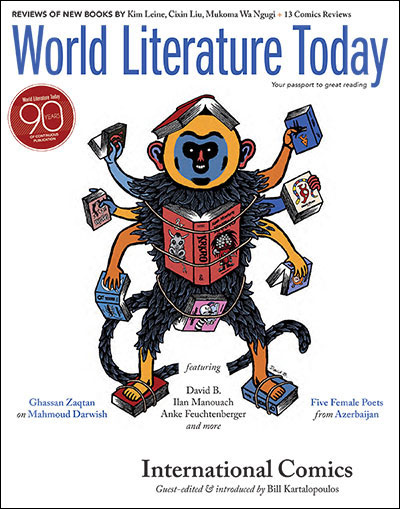From Catalan Poetry to Fortuny Gowns: A Conversation with Pere Gimferrer
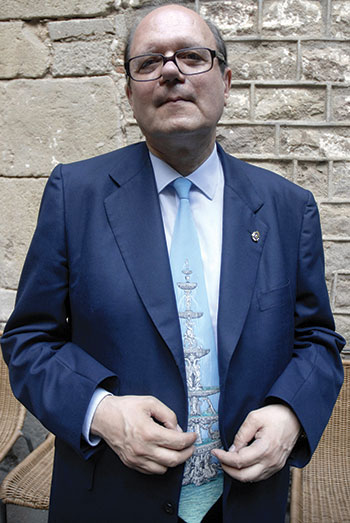
Pere Gimferrer i Torrens is a poet, novelist, translator, and critic with some fifty books to his name. Despite countless awards and the praise of such writers as Roberto Bolaño, Octavio Paz, and Juan Goytisolo, his work was largely unknown in English when I translated his long poetry cycle Alma Venus in 2014. Shortly afterward, I began work on his novel Fortuny, an elegy for the Belle Époque in extremely lush, poetic prose, released by David R. Godine in February 2016. This past December, I arranged to meet Gimferrer in his office at the publisher Seix Barral, where he works as editorial director. The space is a bit less frightfully disordered than in the photos I had seen of it before: apparently the thousands of books piled on the desk, floor, and shelves were recently deemed a hazard, and workers have since cleared them out.
Adrian Nathan West: You published your first book, Mensaje del tetrarca, fifty-two years ago—
Pere Gimferrer: True, but that’s a rather juvenile and not very representative book . . .
ANW: In any case, you’ve enjoyed unquestioned renown in Spain in the years since. You’ve won many prizes, you’re a member of the Spanish and Catalan language academies, and Harold Bloom included your work in the list of Spanish authors essential to the Western canon. Nonetheless, your poetry was only translated into English in 2014. How would you describe your trajectory to a reader unfamiliar with your work?
PG: I’ve written in four languages, though mainly in Spanish and Catalan. One book in Italian and a chapbook in French. My own work arises as an attempt to expand upon the poetry that existed in the West in the 1930s, the course of which was disrupted by World War II and the Spanish Civil War. War left its traces on poets the world over, from Cummings to Auden to Eliot, and obviously throughout Europe and Latin America, but the effects in these countries can’t be compared to the abrupt break that took place in Spain, where because of the civil war, the normal aesthetic evolution was abandoned and the poetry that should have been written in ’36 or ’39 was lost. There was a step backward, aesthetically and morally, and neither the poets who stayed nor those who went into exile followed the path they would naturally have taken. I wanted to write as though the civil war hadn’t left this imprint on literature.
ANW: How would you describe the form and genesis of Fortuny?
PG: The story behind it is very simple: in the year 1980–something, I had a date at the Fortuny Museum, which was abandoned at the time—not completely, but still in quite precarious conditions. With the notes I took in Venice and those I made on my return, I sketched out an extensive outline for the novel. Not long afterward, just before beginning the first page, I thought: why draw this out into the form of a story? So Fortuny is an amplification of a novel that I conceived but didn’t care to write, because I thought this kind of skeletal form suited it better.
ANW: It’s an interesting book because it has an immense cast of characters, but all of them are, in a way, like ghosts . . .
PG: Well, everything I write there is or could be true, except that almost no one ever speaks. I think it just happens once in the book. That relates to ideas I had then about changing the narrative genre.
ANW: The characters and settings are classical but at the same time, the approach is cinematic, reminiscent of the nouveau roman.
PG: It’s true, there are things in it that bear an undeniable relation to the Georgics of Claude Simon, even if their form is much more synthetic in Fortuny.
ANW: I say this because there is a great deal of tenderness but also an absence of psychology . . .
PG: The characters have no psychology whatsoever. And I deliberately limited myself to a plastic approach somewhere between the art pompier and kitsch of Fortuny père and fils, albeit in a style that employs a great deal of rare vocabulary.
ANW: You are a great reader of Proust—in fact, the first time I heard your name was when my French professor said to me, with reference to Fortuny, “There is a Catalan who writes like Proust.” But the ekphrastic element, so important in chapters like “The Odalisque” or “Henriette,” more readily invokes Proust’s master, Ruskin.
PG: Yes, Sesame and Lilies. I saw the place where Ruskin wrote in Venice [here Gimferrer proceeds to give precise directions to the commemorative plaque to Ruskin on the Zattere, almost as if I were due to go there after leaving his office]. But the case of Proust is different—he knew Fortuny personally, Fortuny is a character is his book. Fortuny also knew Orson Welles, as I mention in the book. He was there during the recording of Othello. He doesn’t always show up in the credits, but he does in the copy they show in Italy.
ANW: Your work in general is marked by a very dense web of references, the representation of memory, and experience through allusions to cinema, art, and literature.
PG: Sure, but my aim isn’t for the reader to grasp all of them. You caught more than I thought you would [in the notes to Alma Venus]. That’s all well and good, but . . . Look, the poem has a way of functioning, and it’s not indispensable that the reader understand or know everything. In your version, there’s fairly extensive information added, but I didn’t put that in Spanish; for me that’s something for a critical edition or perhaps for a translation. There are notes in The Waste Land, but some of them steer you wrong. Not the important ones, but there are things there to distract the reader and, as Octavio Paz said, to pad the book out as well.
ANW: How should readers approach this kind of work?
PG: They can try to learn things, and there is no reason not to, but I’ve failed if I don’t manage to impart some measure of poetic effect even without their doing so. Eliot and Pound knew how to do this clearly: you can read The Waste Land and the Quartets, and almost all of Pound, without knowing what they’re talking about at every moment, and this doesn’t put their poetic vigor in doubt.
ANW: A constant reference in your work is a poet who is almost unknown outside of Spain: Ausiàs March. Could you sum up his importance for an anglophone reader?
PG: He’s a very important medieval poet. He’s not had an impact in English, not that I know. His influence in Spanish poetry is broad, reaching even to Garcilaso de la Vega; but in fifteenth- and sixteenth-century Spain, in great contrast to the present moment, a cultured person understood Catalan and could read Ausiàs March in the original.
I recommend the Provençal poets and the Galician-Portuguese troubadours. The medieval is a completely different world.
ANW: How would you situate his importance within the history of world poetry?
PG: He is completely distinct from the troubadors and has nothing, or almost nothing, to do with the dolce stil nuovo. He’s introspective, philosophical, the rare case of a psychological poet in the medieval era. He bears a certain very distant relation with Villon, though with obvious differences, because the one was a knight and the other was a thief. Among modern poets, he has a strange resemblance to Baudelaire, above all.
ANW: You’ve said that Spanish has lost its poetic efficiency. This is increasingly a problem in English as well. Success in the market requires a neutral, internationalized language, stripped of localisms or anything that might make access difficult; at the same time, the jargon of the business world has crept into artistic prose and poetry: we read “morph” instead of change, “reference” instead of “refer to,” and a growing profusion of words ending in “-ize.” Is it possible for a language to lose its enchantment, or is there always some vein of poetic force in reserve?
PG: I don’t believe it vanishes, not entirely anyway. Spanish has lost certain syntagmas, as happens in any language when it hasn’t been used much, but there are things, you know, that continue to function. It’s true that many techniques developed in the nineteenth century were overused, and their vigor drained away. But there are things Góngora did that remain as powerful as they were in his day. A loss of power is characteristic of routine usage, but where language is inventive, it continues to have strength. It is very rare that vitality disappears from any truly inventive use of language. And also, in a literary tradition as extensive and diverse as the Spanish—including its American exponents—figures become cliché and lose their efficacy. But this was equally true for a Roman poet in the time of Ovid. There is no such danger so long as the writer has a poetic sense of the language.
ANW: You read a great number of languages. Are there unknown authors we should be more familiar with?
PG: Every language has important writers who are little read in other languages, but this has more to do with the publishing world than with literary tastes per se. Anyhow, it’s worthwhile to ask what reading really means. In Spain today, many more people read Herbert or Marvell than a few decades ago. But in my opinion, they’re only reading them if they read them in English and understand what they are saying. If not, what they’re reading is something else. Few poets are as well known in Spanish as Emily Dickinson. I have to say that very little of Emily Dickinson is understood in translation. Everything depends on shadings, on her strangeness of punctuation. But to answer your question, I recommend the Provençal poets and the Galician-Portuguese troubadours. The medieval is a completely different world.
Our conversation ends with a few anecdotes about the great Spanish novelist Juan Benet, whose career Gimferrer helped establish with an early essay on his novel Return to Región . He talks a bit about the relationship of writers to the academy and the rumored sale of a majority stake in the Adelphi publishing house. I hand him a gift, a book of essays by Cristina Campo. Miraculously, he hasn’t heard of it. “But you know who this is?” he asks, referring to the image on the cover. When I say no, he replies, “I could be wrong, but I’d be willing to bet it’s Lucrezia Borgia.” The title page lists the illustration as Portrait of a Woman, by Bartolomeo Veneto. In my subsequent reading during the editing of this interview, I find that Veneto worked for several years at the court of Alfonso I d’Este, who married Lucrezia, the likely model for this painting, in 1502.
December 2015
Ornithology
by Pere Gimferrer
In a purblind, pulsing darkness, afflicted and secluded like the profaned mummy of an empress, reside the two ladies painted by Carpaccio, with the restless harrier, elegant and airy as a sword, and the cooing, albid dove. The two ladies are swathed in abundant golden dresses: the one above with falcon eyes, the one below with peacock eyes; both with eyes of steel to wound, with eyes of lead to sear, with iron eyes to cleave, with liquid eyes, for they are steeped in the hues of the world in fusion with primordial chaos. The two ladies dressed by Carpaccio, by Hokusai, by Fortuny.
Translation from the Catalan
By Adrian Nathan West
Editorial note: From Fortuny, published by David R. Godine, reprinted by permission of the translator. Translation copyright © 2016 by Adrian Nathan West.
Spain’s most acclaimed living poet, Pere Gimferrer is the author of more than thirty volumes of verse, essays, criticism, and fiction in Spanish and Catalan as well as a recent book in Italian, Per Riguardo. His novel Fortuny has recently been published in English by David R. Godine.




